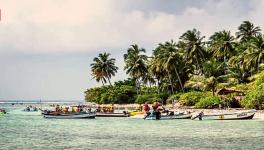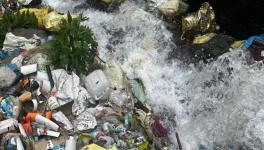Why Govt’s Plan to ‘Develop’ Andaman Island is Shocking
Image Courtesy: New Track English
These columns have covered many issues of environmental damage and the systematic dilution or dismantling of environmental regulations in India under the present dispensation at the behest of corporate interests, all spuriously in the name of “development.” The question raised through these cases has not been the hackneyed ‘Do we want development or environmental conservation?’, but a fundamental one of when the environment is damaged irrecoverably, when it can no longer sustain natural life or livelihoods of people dependent upon it, can all of this still be called “development”?
About a fortnight ago, a very disturbing report appeared in The Hindu about the government’s plans for massive projects in the ecologically fragile Little Andaman Island, home to the near-extinction Onge, a particularly vulnerable tribal group (PVTG). The report is based on a NITI Aayog project document titled ‘Sustainable Development of Little Andaman Island - Vision Document,’ which is not available in the public domain, but whose existence or the contents of the newspaper report have not been denied, either by the NITI Aayog or the government.
The proposed project on Little Andaman, the second most populated island after Great Andaman which includes the capital Port Blair, is said to involve a new greenfield city acting as a tourism and financial services hub with all kinds of modern amenities such as hotels, a convention centre, airport, seaport etc, aspiring to ultimately rival Singapore or Hong Kong!
Research towards examining the issue further revealed that various related reports have indeed appeared in the print and online media over the past few years which confirm that such plans not only exist, but work to make it a reality have advanced considerably, including through detailed interactions with Indian and overseas corporate, but largely away from the public gaze. This article seeks to throw more much-needed light on this project whose scope and scale are astounding and profoundly shocking.
Vision & Project
According to The Hindu report, the project is spread over three zones: the first covering 102 sq. km along the east coast with a full-size airport which can host all aircraft types, aerocity, an expanded jetty and marina, tourism centres, convention centres, and hospitals or ‘medicity’; the second a leisure district spread over 85 sq. km of pristine forest with a tourism SEZ, film city and residential area, and the third a 52 sq. km zone with a nature retreat, forest resort and natural healing facilities.
That’s not all, of course! There are resorts, underwater facilities, casinos, ready-to-use office complexes, drone ports and so on. As if this was not enough, a new 100 km east-west coastal ring road and a mass transit system with numerous stops are also in the works.
Just the first three zones described above cover around 250 sq. kms and the built-up portion could be much more if one includes all the infrastructure. The total area of the island is around 737 sq. kms – about the size of Mumbai or Hyderabad, of which 95% or about 700 sq. km is reserve forest. Of this, about 450 sq. km is designated as the Onge Reserve. The Project calls for clearing about 224 sq. km or 32% of the reserve forest with around two million trees and de-notifying 135 sq. km or about 30% of the Onge Reserve.
The Forest Department reportedly objected to the project citing massive environmental damage, threat to the Onge population and harm to wildlife including habitats and breeding grounds of the globally endangered Giant Leatherback sea turtles. But none of this cut any ice with the powerful backers of the project who are said to have simply dismissed the concerns about the forests and wildlife and, unbelievably callously, suggested that any displaced Onge could be settled somewhere else on the island.
Readers may note that the Onge, one of four major ‘Negrito’ tribes in the Andaman Island group, now number only 110 persons, having dwindled to that number since 1900. With the arrival of mainland Indians, some refugees from the Bangladesh war of 1971 and a small number from the Nicobar Islands totaling around 18,000 on Little Andaman island, the Onge were “settled” in two tiny reserves near the western coast.
The Onge, along with other Andaman tribes are believed to have been part of the early out-of-Africa migrations around 50,000 years ago and are barely managing to survive as a viable group after waves of settlements and conflicts under the British colonials and later under mainland India. India’s latter-day policy of respecting the preference chosen of the Andaman islands’ tribal peoples for isolation and non-contact with outsiders, has already pushed the Jarawas in that island to a dysfunctional existence or sub-optimal isolation in the deepest interiors of the Great Island with Port Blair in the north of the chain.
The Onge are likely to be similarly pushed closer to extinction by this project if it materialises. But do the project proponents care?
Other Similar Projects
Different ideas for development in the Andaman islands have come up and been discussed over the years, but at present concerted efforts are underway and being pushed aggressively.
In 2017, the Government had constituted an Island Development Authority under the chairmanship of the Home Minister, and this apex body tasked the NITI Aayog with preparation of a Holistic Development of Islands programme. In mid-2018, NITI Aayog made a detailed presentation to potential corporate investors of plans to set up “eco-tourism” resorts, island water villas, infrastructure projects such as jetties, marinas, roll-on-roll-off ferry projects, a string of regional airports, heliports and sea-plane operations, a transshipment port in South Bay in Little Andaman island, and several projects in the Nicobar Islands and major projects in Lakshadweep and Minicoy islands as well. Several of these seem also to form part of the later Little Andaman Project, even if in a modified form.
Significantly, the whole programme was sold to investors as including “pre-approved clearances” from Coastal Zone Regulations, Environment Appraisals, NGT approval etc, some of which are believed to have actually been received!
NITI Aayog also prepared a "Think Report" in 2018 titled ‘Transforming the Islands through Creativity and Innovation’ with the help of several international consultancy organisations who apparently also conducted carrying capacity studies in the different islands in both the Andamans and Lakshadweep where projects were envisaged.
The projects envisaged tourist numbers of between 5,000 and 10,000 per day in each of these island projects, supposedly within their carrying capacity, compared with the present much-bemoaned low level of tourist arrivals of around four lakh per year in the Andaman and Nicobar islands but with only a more or less flat 15,000 to 18,000 foreign tourists over much of the past decade.
At the projected rate of tourist arrivals, these projects estimate an astounding several million tourists a year, even more than the Indian mainland! Could not the same level of tourism be achieved by expanding and improving the tourist infrastructure in mainland India itself?
These various Andaman Islands development projects are also sought to be sold as advancing India’s security through bustling economic activity and sizeable population in the island chain less than 100 km from the strategic Malacca Straits. But surely that purpose can be achieved by other means, if need be by strengthening physical presence in the area.
Risks and Challenges
However, none of the project documents or reports mentions the risks, challenges and environmental impact of the envisaged large-scale tourism in this largely sparsely populated island chain.
The Andaman & Nicobar islands are in a seismically highly active zone. The 2004 earthquake and accompanying tsunami devastated large parts of the island chain. Nicobar and Car Nicobar lost almost one-fifth of its population and close to 90% of its mangroves. Many islands were completely submerged or even split into two.
In the Andamans, almost all indigenous tribes survived, with inherited native wisdom making them move to higher ground when they noticed the sharply receding sea, knowing that huge waves will follow. The islands themselves, however, were not so lucky. Little Andaman island was perhaps the worst affected, with the tsunami hitting so hard that it not only went past the breakwater but also physically shifted it. The islands are relatively low and coastal erosion is already at threatening magnitudes. Sea-level rise due to climate change is an imminent threat with experts predicting that many of the islands may become uninhabitable by 2100.
Maybe the champions of these plans thought of replicating the success of the Maldives, which receive around 6,00,000 tourists a year. However, they have probably not looked at the environmental damage in the Maldives due to the high-density population of around 5,50,000 and that caused by tourism with implications for coral reefs, fish catch and marine ecosystems, as much a worry there as climate change. It is also noteworthy that a substantial part of the tourism infrastructure in the Maldives is in scattered, uninhabited islands.
It has been three years since these Island Development plans were advanced, including the recent Little Andamans “super project” dangling all kinds of inducements to the corporate sector, both domestic and international. Reports say that no investors have come forward so far, possibly in response to the risks, challenges and viability doubts. So there may be some hope after all!
There are many alternatives to the quixotic plan to “develop” the Andaman islands. But will they even be looked at? Or in the style now familiar with the present dispensation, will the government simply push ahead with their original idea mindlessly, regardless of the consequences?
D. Raghunandan is a senior journalist. The views are personal.
Get the latest reports & analysis with people's perspective on Protests, movements & deep analytical videos, discussions of the current affairs in your Telegram app. Subscribe to NewsClick's Telegram channel & get Real-Time updates on stories, as they get published on our website.
























